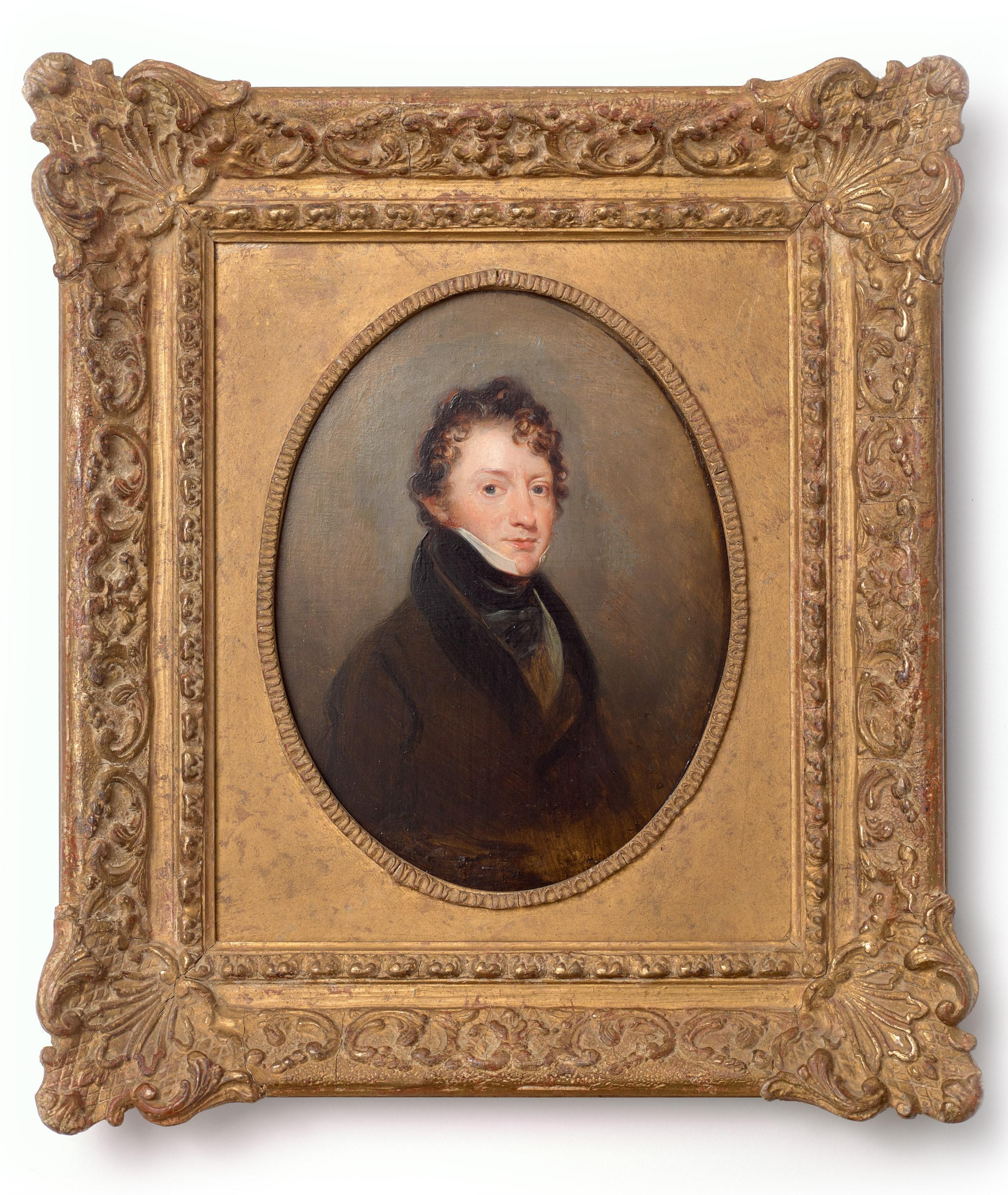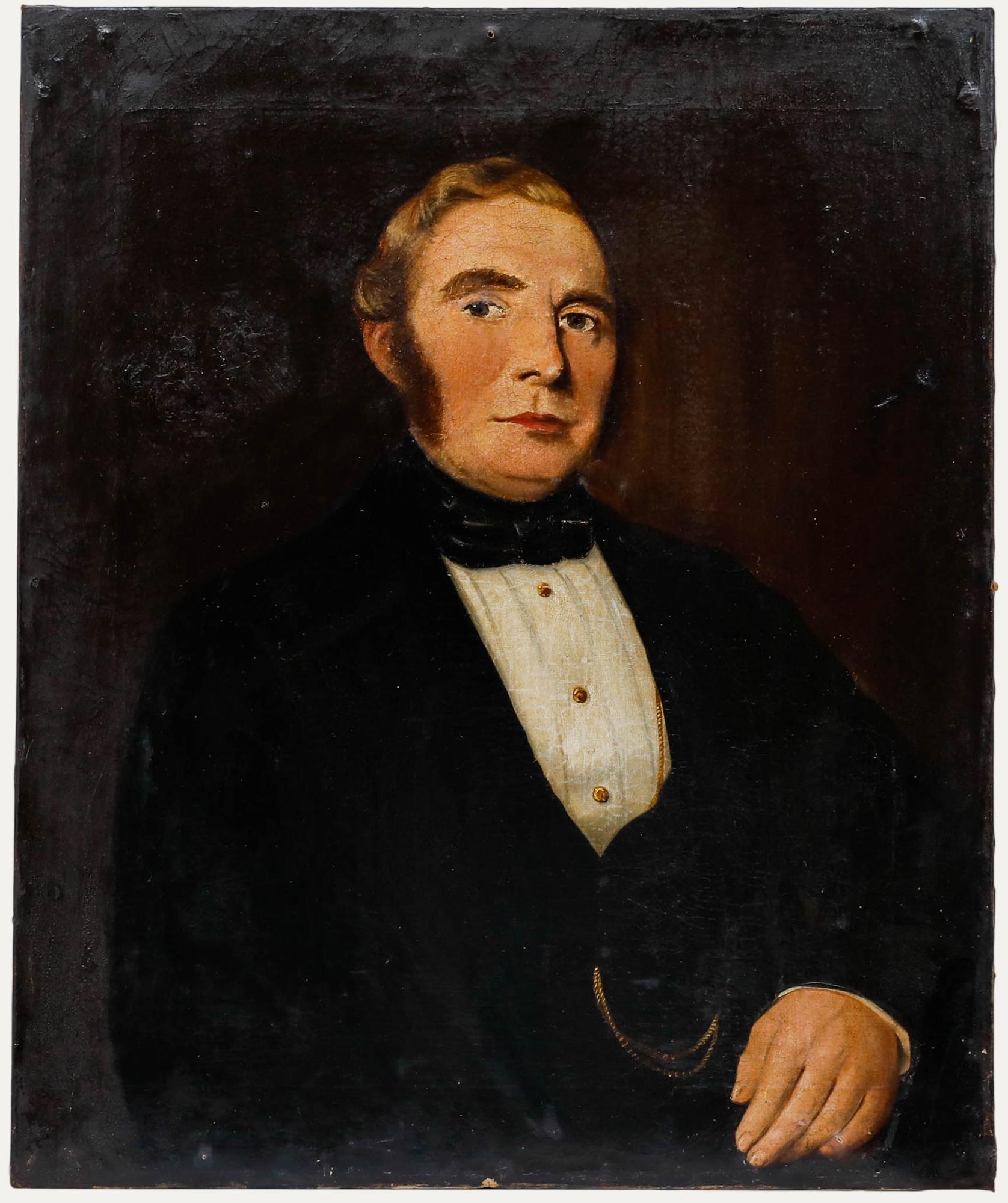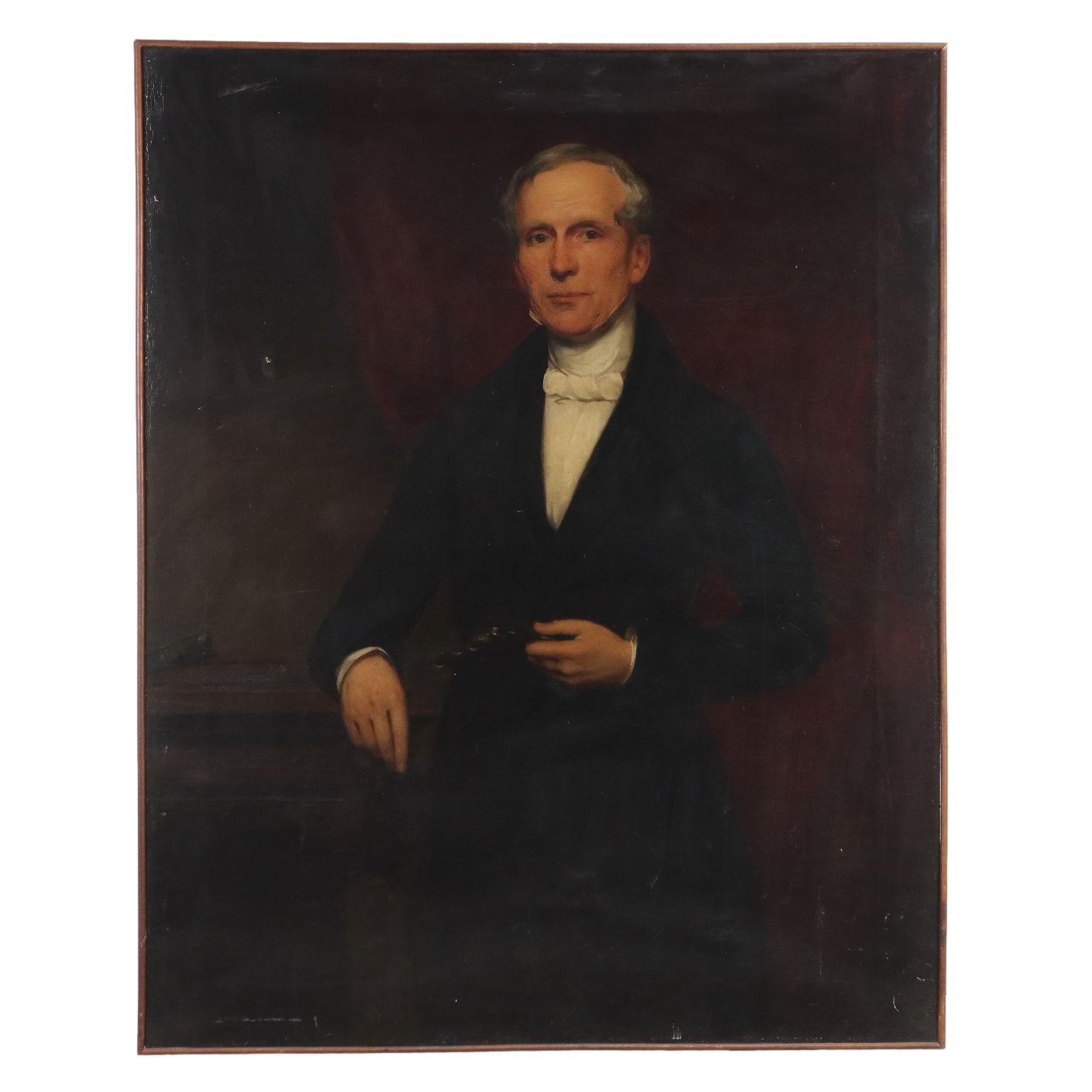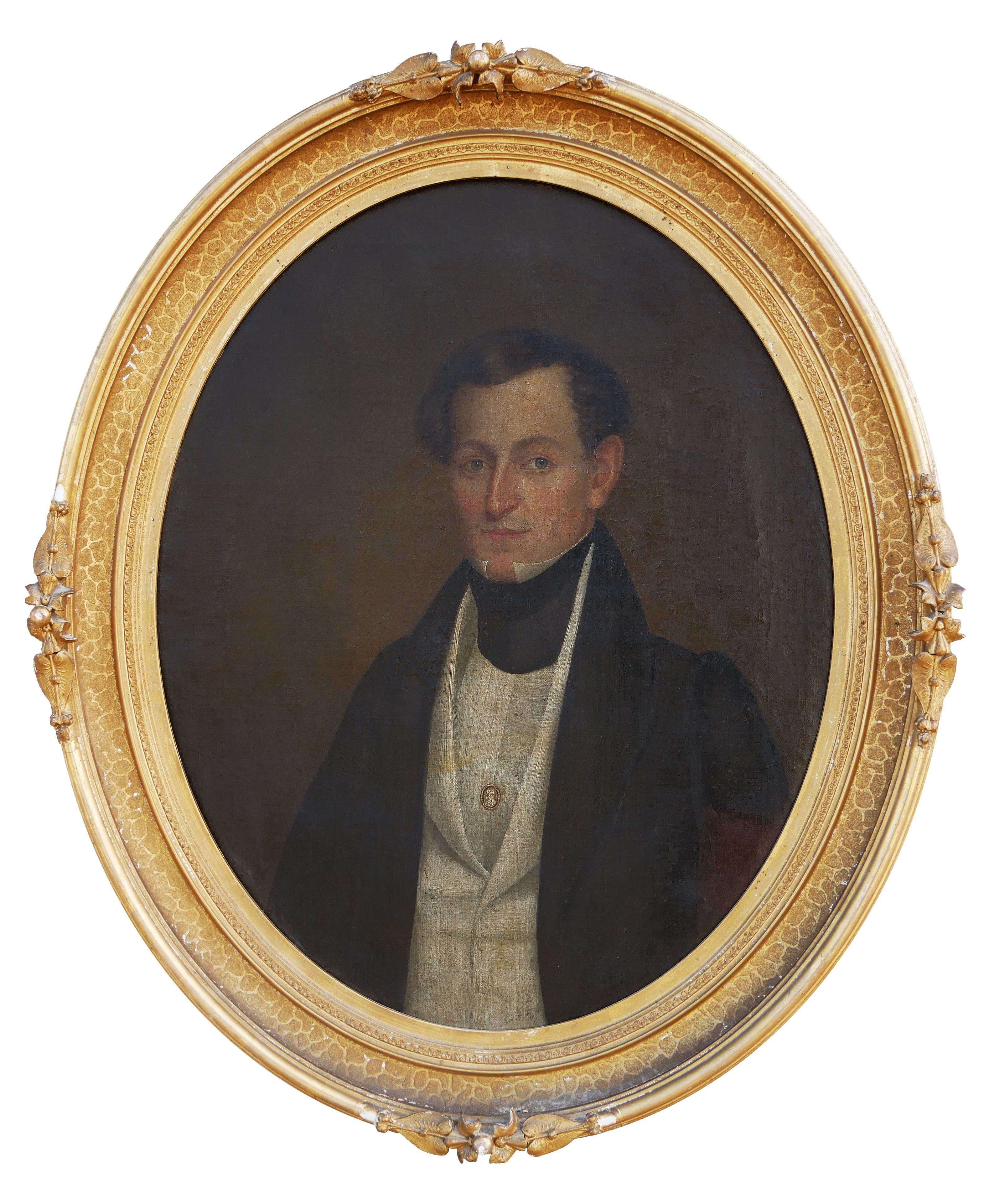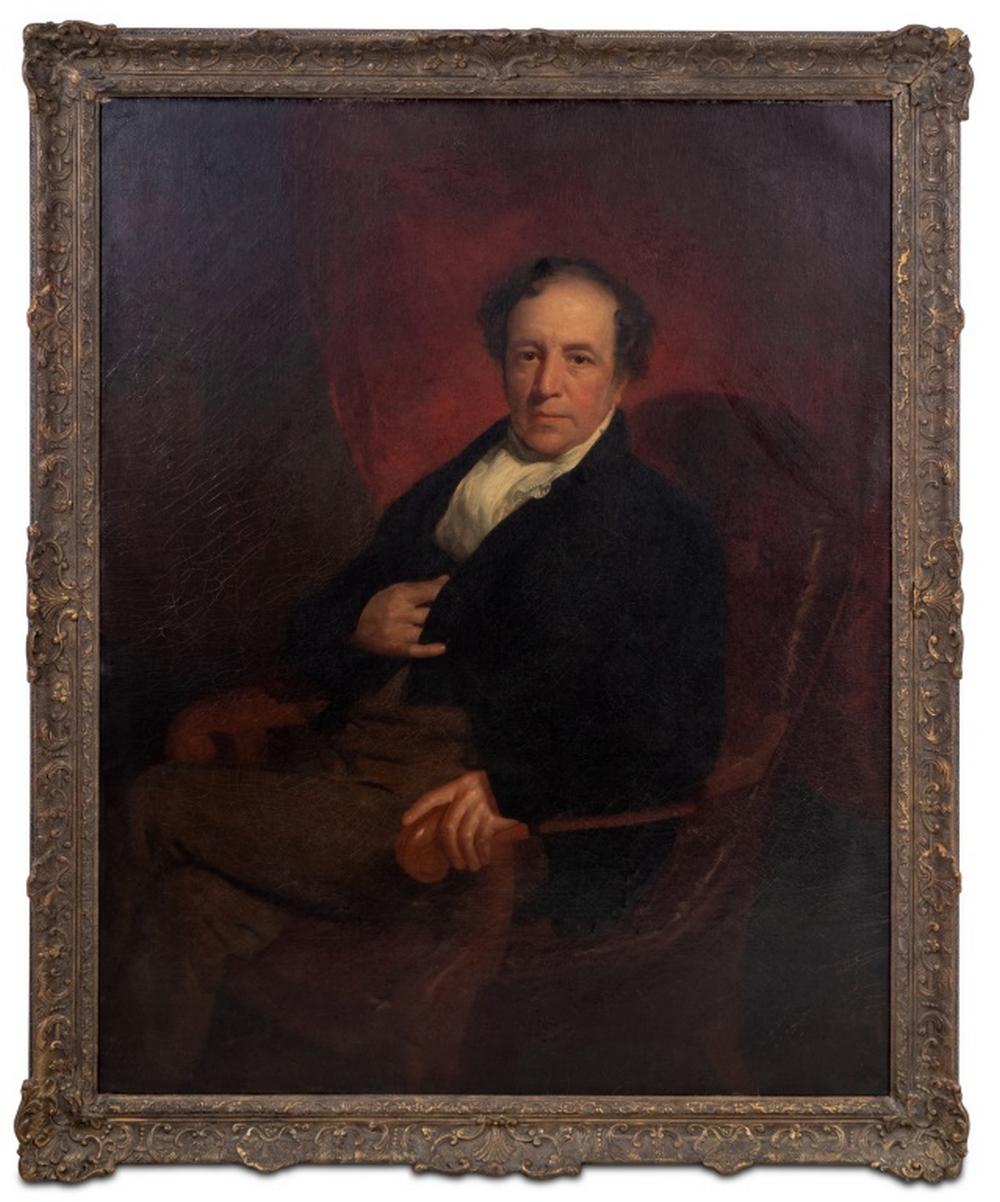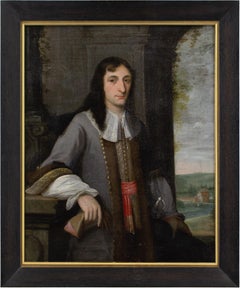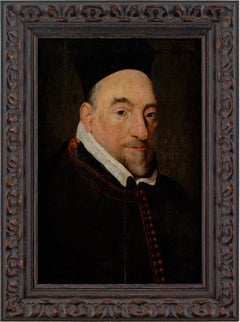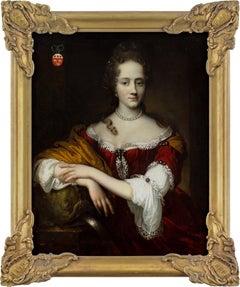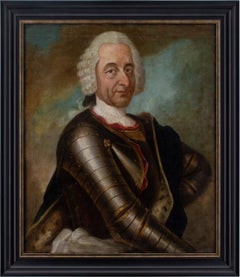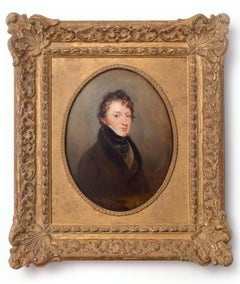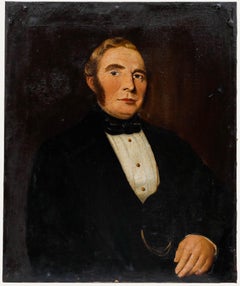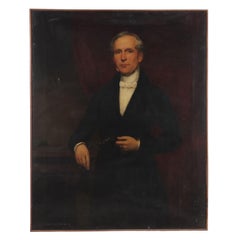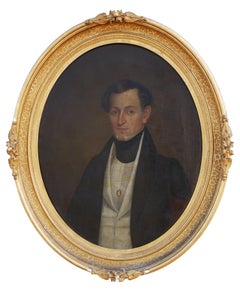Items Similar to John Robert Wildman, Portrait Of A Gentleman
Want more images or videos?
Request additional images or videos from the seller
1 of 13
John Robert WildmanJohn Robert Wildman, Portrait Of A Gentlemanc. 1840
c. 1840
$1,538.58
£1,100
€1,313.64
CA$2,104.74
A$2,355.26
CHF 1,229.81
MX$28,955.51
NOK 15,515.45
SEK 14,599.96
DKK 9,800.76
Shipping
Retrieving quote...The 1stDibs Promise:
Authenticity Guarantee,
Money-Back Guarantee,
24-Hour Cancellation
About the Item
This mid-19th-century oil painting by British artist John Robert Wildman (1788-1843) depicts a gentleman wearing a dark brown frock coat with waistcoat, white shirt and cravat. He bears a passing resemblance to the romantic poet, William Wordsworth (1770-1850).
Slightly crumpled, a little dishevelled, cravat rather hastily tied, he’s evidently a man absorbed by his work. What appears to be a small magnifying glass hangs from his coat - perhaps a clue as to his occupation.
Born in Lambeth, London, Wildman was initially trained by his father but little else is known about how he developed such a keen reputation as a portraitist. During the 1820s, he rose to prominence when producing numerous works depicting the notable figures of his day. Many of these were engraved for various publishers and disseminated widely.
Around 1820, he produced a scene featuring the Yorkshire landowner, and member of parliament, Walter Fawkes accompanied by a rather stout J.M.W. Turner in the grounds at Farnley Hall. How he came to paint them is unclear but he certainly moved within the right circles.
Following his debut at the Royal Academy, British Institution and Society of British Artists, he continued to work from his London studio, living first in Mile End and later at Beaumont Square in Stepney with his wife and five children. All was apparently well and in 1841, a Royal commission followed when Prince Albert sat for him.
However, the following year, his wife Elizabeth died prematurely leaving him to raise his family single-handed. And to compound his distress, he had become seriously unwell, resulting in a near-total loss of income. The Art Union published a plea in the hope of attracting an act of philanthropy, but to little avail - in 1843, he died of “general debility”.
“Mr. John Robert Wildman, a Portrait Painter of considerable talents, has been suffering from illness so severe for the last two years, as to render him utterly incapable of pursuing his profession; his means of subsistence are entirely exhausted; he has a young family entirely dependant on him for support, and has had the misfortune recently to lose his wife by sudden death. Subscriptions will be thankfully received, and specimens of his works shown, by Messrs. Welch and Gwynne, 24, St. James's Street, Printsellers to the Royal Family.”
The life and trials of John Robert Wildman serve as a poignant reminder of the fate of many early 19th-century painters who, despite their evident skill and reputation, were consumed by the realities of their environment. He remains underrated.
Signed/inscribed on the reverse and held within a later frame.
Labels & Inscriptions: Inscribed on the reverse.
Provenance: Private collection, UK.
Artist’s auction maximum: £12,650 for ‘Portrait of a Young Girl’, Oil on canvas, Christie’s, Old Master Paintings, New York, 1995 (lot 85).
- Creator:John Robert Wildman (1788 - 1843, British, English)
- Creation Year:c. 1840
- Dimensions:Height: 35.5 in (90.17 cm)Width: 30.5 in (77.47 cm)
- Medium:
- Period:
- Condition:Cleaned. Revarnished. Canvas relined. Craquelure throughout. The paint layer is stable. Old repairs. Frame in excellent condition.
- Gallery Location:Cheltenham, GB
- Reference Number:1stDibs: LU2328215315612
About the Seller
5.0
Platinum Seller
Premium sellers with a 4.7+ rating and 24-hour response times
Established in 2017
1stDibs seller since 2023
234 sales on 1stDibs
Typical response time: 1 hour
- ShippingRetrieving quote...Shipping from: Cheltenham, United Kingdom
- Return Policy
Authenticity Guarantee
In the unlikely event there’s an issue with an item’s authenticity, contact us within 1 year for a full refund. DetailsMoney-Back Guarantee
If your item is not as described, is damaged in transit, or does not arrive, contact us within 7 days for a full refund. Details24-Hour Cancellation
You have a 24-hour grace period in which to reconsider your purchase, with no questions asked.Vetted Professional Sellers
Our world-class sellers must adhere to strict standards for service and quality, maintaining the integrity of our listings.Price-Match Guarantee
If you find that a seller listed the same item for a lower price elsewhere, we’ll match it.Trusted Global Delivery
Our best-in-class carrier network provides specialized shipping options worldwide, including custom delivery.More From This Seller
View All17th-Century Flemish School, Portrait Of A Gentleman In A Justaucorps
Located in Cheltenham, GB
This fine late 17th-century Flemish portrait depicts a distinguished gentleman wearing a justaucorps, black cloak, white shirt, vest, leather gloves, and breeches. He’s carrying a wi...
Category
1670s Old Masters Portrait Paintings
Materials
Oil, Canvas
Mid-17th-Century Flemish School, Portrait Of Cornelius Janssen
Located in Cheltenham, GB
This mid-17th-century bust-length Flemish school portrait depicts the Dutch Catholic bishop Cornelius Janssen (1585-1638). Painted when into his later years, this intriguing historic...
Category
1630s Flemish School Portrait Paintings
Materials
Wood Panel, Oil
Johannes Vollevens I, Portrait Of A Member Of The Van Vrijberghe Family
Located in Cheltenham, GB
This splendid late 17th-century three-quarter-length portrait by Dutch artist Johannes Vollevens I (1649-1728) depicts a lady wearing a plush red gown with a low, lace-trimmed neckli...
Category
17th Century Dutch School Portrait Paintings
Materials
Canvas, Oil
Mid-18th-Century German School, Portrait Of An Aristocrat In Armour
Located in Cheltenham, GB
This mid-18th-century half-length German portrait depicts a middle-aged aristocrat wearing armour and a wig.
Despite his heavily-clad appearance, it’s likely that this rather noncha...
Category
1750s Old Masters Portrait Paintings
Materials
Canvas, Oil
Anton Benno Zottmayr, Portrait Of A Gentleman With A Letter
Located in Cheltenham, GB
This charming mid-19th-century oil painting by German artist Anton Benno Zottmayr (1795-1865) depicts a gentleman holding a letter. Zottmayr was an accomplished painter of portraits,...
Category
1850s Folk Art Portrait Paintings
Materials
Oil, Canvas
George Clint ARA (Attributed), Portrait Of A Lady In A Brown Dress
Located in Cheltenham, GB
This early 19th-century half-length portrait attributed to British artist George Clint ARA (1770-1854) depicts a young lady wearing a beautiful brown dress, bonnet decorated with small flowers, gold earrings and coral necklace. Clint was a distinguished painter and mezzotint engraver predominantly known for portraiture and dramatic scenes.
Set before an evocative classically-inspired backdrop, she looks out from across the centuries with a composed demeanour. Adorned in the latest fashions, oversized ‘gigot’ sleeves, a delicately-poised bonnet, and a coral necklace for good luck. It’s a charming portrayal by a masterful hand.
Born at Drury Lane, in the heart of London’s West End, George Clint was destined to lead an exuberant life amid the spectacle of theatreland. His father, Michael Clint, was a hairdresser during a time of “hair pomatum, whalebone, wire, lace gauze, and feathers” - so young George would have encountered a variety of ‘characters’ during his childhood.
But despite these elevated surroundings, he soon discovered the darker side of London when thrust into the world of employment. Apprenticed initially as a fishmonger, he trained under a ferocious master who was known to beat him. The hours were unsocial, the conditions rank, and the work was brutal. He soon quit but subsequently found himself toiling for a corrupt attorney who demanded he undertake unscrupulous acts on his behalf.
Seeking a less volatile role, he turned next to house painting, at which he excelled. Commissioned, among other projects, to paint the stones of the arches in the nave of Westminster Abbey. Aside from an incident whereby he almost fell from the second story of a building, all was going well.
Following his marriage in 1792 to Sarah Coxhead, a farmer’s daughter, he began work in earnest as a painter of miniatures, determined to forge a career. Robert William Buss’ memoir celebrates Clint’s success as a miniaturist, stating that “great manual excellence was united with that chaste, delicate feeling for female beauty which characterised all Mr. Clint's portraits of ladies.”
Until this point, it appears he was predominantly self-taught, presumably constrained by a lack of finances. But from hereon in, his industrious nature coupled with several fortunate encounters, led to him developing an enviable talent for both painting and engraving. During the early 19th-century, the acquaintances one kept could make or break your fortunes and perhaps acutely aware of this, Clint’s ‘society’ was an ever-evolving circle of influential personalities.
He was “initiated into the mysteries of engraving” by Edward Bell (act.1794-1819) and produced numerous works after the foremost artists, such as George Stubbs, John Hoppner, and Thomas Lawrence. Following a commission from Lawrence, he struck up a long-term friendship.
Admired for his skill as a mezzotint engraver, he sought next to hone his technique in oils and, as with many aspiring portraitists, his first work in this respect was a depiction of his beloved wife. The pair were both delighted with it, yet over time Clint began to doubt himself and sought the validation of a superior hand - that of Sir William Beechey (1753-1839). However, paralysed with insecurity, he couldn’t face the potential criticism, so his wife took it instead - “with a child under one arm and the portrait in the other”. The result was immeasurably more positive than he’d envisaged and he became closely associated with Beechey until his death in 1839.
Numerous commissions followed from the landed gentry including Lord Egremont, Lord Spencer, and Lord Essex. But also from the theatrical community who would fill his studio at 83 Gower Street, Bloomsbury. His connections within the world of acting led to notable works such as ‘Malvolio and Sir Toby’ (from William Shakespeare's 'Twelfth Night', Act II, Scene iii)’ and ‘Harriet Smithson as Miss Dorillon, in Wives as They Were, and Maids as They Are’.
While his efforts in mezzotint included several contributions to JMW Turner’s Liber Studiorum.
As a measure of his success, Clint was elected an Associate of the Royal Academy in 1821 - a position he later relinquished for personal reasons. Today, he’s represented in numerous public collections including at The British Museum, Harvard Art Museums, The Met, V&A, Yale Center for British Art, and the National Portrait Gallery.
“The respect in which he was held, not only by his brother artists, but by an immense number of eminent men in various professions, and others of the highest rank, was the result of a rare combination of talent, candour, suavity of manner, and integrity of purpose”. [Obituary, 1854].
Housed in a period gilt frame, which is probably original.
Learn more about George Clint ARA in our directory.
Labels & Inscriptions: Supplier’s stencil from Rowney & Forster. The National Portrait Gallery holds a database of supplier’s stencils over the decades. The one here is also presented on two other works by George Clint. ‘Falstaff’s Assignation with Mrs Ford...
Category
1830s English School Portrait Paintings
Materials
Oil, Canvas
You May Also Like
Portrait of John Manners later 7th Duke of Rutland
By Margaret Sarah Carpenter
Located in Douglas, Isle of Man
Margaret Sarah Carpenter 1793-1872, was an English portrait painter. She was one of the foremost portrait painters in the 19th Century, she exhibited at the Royal Academy, British In...
Category
1830s Portrait Paintings
Materials
Oil, Panel
J. A. Giles - Mid 19th Century Oil, Portrait of a Victorian Gentleman
Located in Corsham, GB
This striking portrait depicts a Victorian gentleman in formal 19th-century attire. The composition is classic and dignified, with the subject's upper body and face occupying most of...
Category
Mid-19th Century Portrait Paintings
Materials
Oil
Portrait of Lord Wood of Inchyra 19th century
Located in Milan, IT
Oil on Canvas. On the back is cartouche with attribution and title of the work.
Sir John Watson Gordon established himself as a portrait painter, producing portraits of a great many ...
Category
Mid-19th Century Other Art Style Portrait Paintings
Materials
Oil
$1,576 Sale Price
20% Off
American Portrait Painting of a Gentleman of the Verplanck Family
Located in Houston, TX
The painting features a 3/4 bust portrait of a gentleman from the Verplanck family of Orange County, New York. The painting shows a young man seated for her portrait in a fine black ...
Category
1820s American Realist Portrait Paintings
Materials
Canvas, Oil
Portrait of a man
By Antoine Jean Gros
Located in Paris, IDF
French school from the beginning of the 19th century
Three-quarter bust portrait of a man
Oil on panel
28 x 21 cm
Circa 1820
This portrait of a man, typical of the French school o...
Category
Early 19th Century French School Portrait Paintings
Materials
Oil
English School Portrait of Gentleman Oil on Canvas
Located in Astoria, NY
English School, Portrait of a Gentleman, Oil on Canvas, circa 1830, the figure seated in an armchair, unsigned, according to a typed label verso depicting "Lord John H. Morelan(d)", ...
Category
1830s Portrait Paintings
Materials
Canvas, Oil
More Ways To Browse
Antique Hand Paint Portrait
Antique Gentleman
Art Magnifying Glass
Antique White Shirt
Antique End Of Day Glass
19Th Century Reverse Glass Paintings
Antique Magnifying Glasses
19th Century Reverse Painting On Glass
Early Magnifying Glass
Antique Cravat
Sator Square
Antique Frock Coat
Vintage Scifi Movie Posters
Vintage Weight Lifting Posters
Vintage Westmoreland Glass
Virginia Burnett
Visser T Hooft
Warhol Basquiat Boxing Poster 1985
